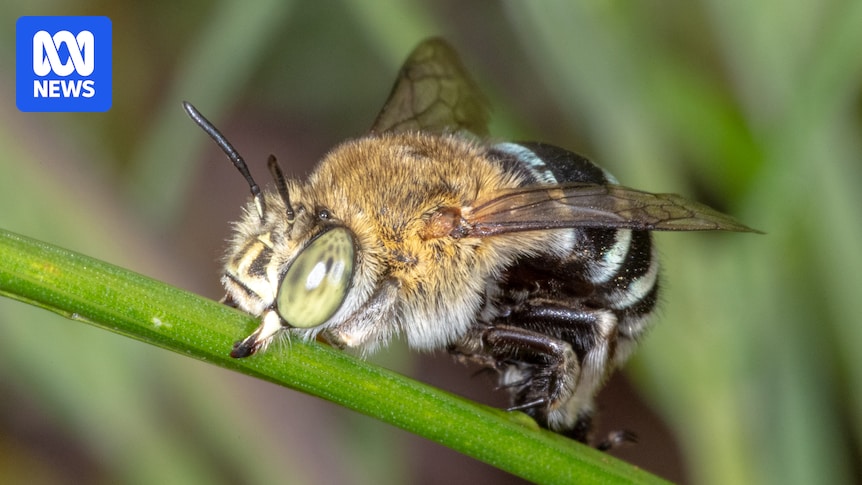A super-fast super fly with wings that beat more than 300 times per second, a moth that migrates nearly 1,000 kilometres each spring, or a well-dressed native bee that is a pollinator extraordinaire?
What will be the first ABC Insect of the Year?
The ABC has begun its quest to find out which native six-legged marvel is Australia’s most popular insect for 2024.
Six insect experts have selected their finalists for the inaugural award.
You can vote for the winning invertebrate via an online poll during October.
Bogong moths migrate from as far as Queensland to alpine regions in NSW and Victoria each year. (Supplied: Ajay Narendra)
Museums Victoria Research Institute’s senior curator of entomology Dr Ken Walker says recognising the role insects play in pollination, pest control and as a source of food for other native animals is overdue.
“Insects have been affectionately called the little things that run the world,” Dr Walker says.
“Most insects are beneficial and they play important roles in our environment and ecosystems.”
Dr Walker says insects are pollinators, decomposers, herbivores, scavengers, soil mixers, soil aerators, nutrient recyclers, seed dispersers, biocontrol agents, medicinal agents, predators and parasites.
He says they also provide food for many other animals, including humans.
Ken Walker says insects play important roles in our environment and ecosystems. (Supplied)
“They come in all types of sizes and amazing colours that fill our imagination and flights of fantasy,” Dr Walker says.
“Insects and humans share the same world filled with similar opportunities and challenges, and yet we often pay insects little attention to their needs and their rights to survive and flourish.
“The ABC Insect of the Year is one way to encourage us to think and talk more about insects and to find ways to make our planet more sustainable for its many variable life forms.”
This year’s ABC Insect of the Year expert panellists are:
- Museums Victoria Research Institute curator of entomology Ken Walker
- Gardening Australia magazine horticultural editor AB Bishop
- Ecologist Anna Carrucan
- Author and nature photographer Peter Rowland
- ABC Statewide Mornings nature correspondent Tanya Loos
- ABC science writer Ann Jones
Dr Jones says narrowing the field of amazing insects to a finalist has been a tough task.
Ann Jones says insects are no less amazing than giraffes or rhinos. (Supplied: Corey Hague)
“Like a mum, I really can’t pick a favourite unless my life is under threat or I’m faced with decent bribery because every single insect species brings its own skills, beauty and value to the world,” she says.
“It’s easy to fall in love with pandas and chimps and lions — they’re large, charismatic creatures. But, the health of our ecosystems, right here in our towns and cities in Australia, is dependent on much, much smaller creatures.
“Insects may be more cryptic, but they are no less important and no less amazing or enthralling than giraffes or rhinos.”
The 2024 ABC Insect of the Year will be announced in November to coincide with Australian Pollinator Week.
The finalists are …
Blue-banded bee (Amegilla cingulata)
Blue-banded bee. (Supplied: Peter Rowland)
“Blue-banded bees are head-banger rockers.
“They are crucial in buzz pollination of flowers like native kangaroo apples and crop species such as tomatoes, which require vigorous impacts to shake out the pollen.
“Blue-banded bees really are the rock stars of the insect world.”
— Dr Anna Carrucan
Bogong moth (Agrotis infusa)
Bogong moth. (Supplied: Bertram Lobert/Strathbogie Ranges Conservation Management Network)
“The Bogong moth makes the list because it has an incredible migration — nearly 1,000 kilometres — and it’s also an important food source for the critically endangered mountain pygmy possum.”
— AB Bishop
Common hoverfly (Melangyna viridiceps)
Common hoverfly. (Supplied: Peter Rowland)
“Hoverflies are masters of disguise, mimicking bees and wasps, and they are tireless workers and gentle pollinators.
“They can also hover in one spot, which is cool on its own.
“But that’s not all — their larvae are voracious predators of aphids; each one typically eats 300 of these pests over their life cycle.”
— Peter Rowland
Eltham copper butterfly (Paralucia pyrodiscus lucida)
Eltham copper butterfly. (Supplied: Mike Coupar/Museums Victoria)
“Once thought to be extinct, the Eltham copper butterfly was re-discovered in (you guessed it)Eltham.
“There are a handful of locations in Victoria where it can still be found.
“It lives in a three-way relationship with a plant called Sweet Bursaria and Notoncus ants, which usher its caterpillars up and down the plants for feeding at night and naps in the roots and stems during the day.”
— Dr Ann Jones
Golden stag beetle (Lamprima aurata)
Golden stag beetle. (Supplied: David Paul/Museums Victoria)
“They’re often mistaken for Christmas beetles due to their amazing colours.
“The young larvae feed on rotting logs, which is an essential part of forest ecology, and the adults are nectar-loving; therefore, they are great pollinators.”
— Tanya Loos
Lord Howe Island stick insect (Dryococelus australis)
Lord Howe Island stick insect. (Supplied: Rohan Cleave/Zoos Victoria)
“The Lord Howe Island stick insect is a remarkable story of survival and a comeback from the dead.
“It was once abundant on Lord Howe Island, the only place it is known to occur and is large (hand-sized) and flightless.
“By 1923, the Lord Howe Island stick insect was declared to be extinct, but in 2003, it was re-discovered and is now subject to a breeding program at Museums Victoria Research Institute.”
— Dr Ken Walker
How will you vote?
Can’t see the poll? Click here

